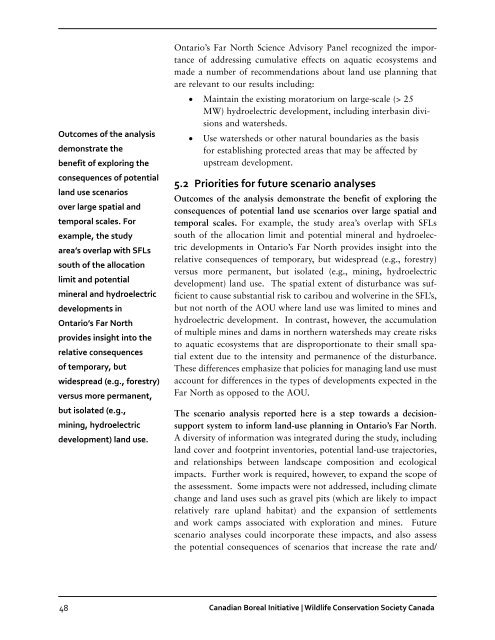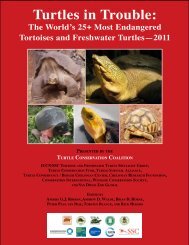You also want an ePaper? Increase the reach of your titles
YUMPU automatically turns print PDFs into web optimized ePapers that Google loves.
Outcomes of the analysis<br />
demonstrate the<br />
benefit of exploring the<br />
consequences of potential<br />
land use scenarios<br />
over large spatial and<br />
temporal scales. For<br />
example, the study<br />
area’s overlap with SFLs<br />
south of the allocation<br />
limit and potential<br />
mineral and hydroelectric<br />
developments in<br />
Ontario’s Far North<br />
provides insight into the<br />
relative consequences<br />
of temporary, but<br />
widespread (e.g., forestry)<br />
versus more permanent,<br />
but isolated (e.g.,<br />
mining, hydroelectric<br />
development) land use.<br />
Ontario’s Far North Science Advisory Panel recognized the importance<br />
of addressing cumulative effects on aquatic ecosystems and<br />
made a number of recommendations about land use planning that<br />
are relevant to our results including:<br />
• Maintain the existing moratorium on large-scale (> 25<br />
MW) hydroelectric development, including interbasin divisions<br />
and watersheds.<br />
• Use watersheds or other natural boundaries as the basis<br />
for establishing protected areas that may be affected by<br />
upstream development.<br />
5.2 Priorities for future scenario analyses<br />
Outcomes of the analysis demonstrate the benefit of exploring the<br />
consequences of potential land use scenarios over large spatial and<br />
temporal scales. For example, the study area’s overlap with SFLs<br />
south of the allocation limit and potential mineral and hydroelectric<br />
developments in Ontario’s Far North provides insight into the<br />
relative consequences of temporary, but widespread (e.g., forestry)<br />
versus more permanent, but isolated (e.g., mining, hydroelectric<br />
development) land use. The spatial extent of disturbance was sufficient<br />
to cause substantial risk to caribou and wolverine in the SFL’s,<br />
but not north of the AOU where land use was limited to mines and<br />
hydroelectric development. In contrast, however, the accumulation<br />
of multiple mines and dams in northern watersheds may create risks<br />
to aquatic ecosystems that are disproportionate to their small spatial<br />
extent due to the intensity and permanence of the disturbance.<br />
These differences emphasize that policies for managing land use must<br />
account for differences in the types of developments expected in the<br />
Far North as opposed to the AOU.<br />
The scenario analysis <strong>report</strong>ed here is a step towards a decisionsupport<br />
system to inform land-use planning in Ontario’s Far North.<br />
A diversity of information was integrated during the study, including<br />
land cover and footprint inventories, potential land-use trajectories,<br />
and relationships between landscape composition and ecological<br />
impacts. Further work is required, however, to expand the scope of<br />
the assessment. Some impacts were not addressed, including climate<br />
change and land uses such as gravel pits (which are likely to impact<br />
relatively rare upland habitat) and the expansion of settlements<br />
and work camps associated with exploration and mines. Future<br />
scenario analyses could incorporate these impacts, and also assess<br />
the potential consequences of scenarios that increase the rate and/<br />
48 Canadian Boreal Initiative | Wildlife Conservation Society <strong>Canada</strong>







![RaLand / SeaScape [PDF] - Wildlife Conservation Society](https://img.yumpu.com/49974326/1/190x245/raland-seascape-pdf-wildlife-conservation-society.jpg?quality=85)









